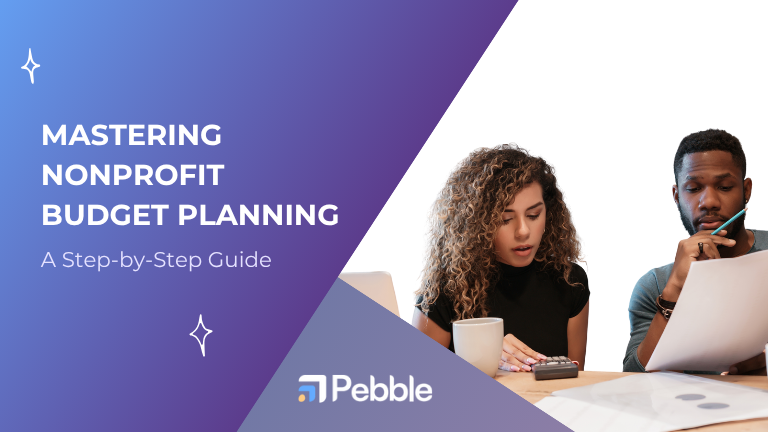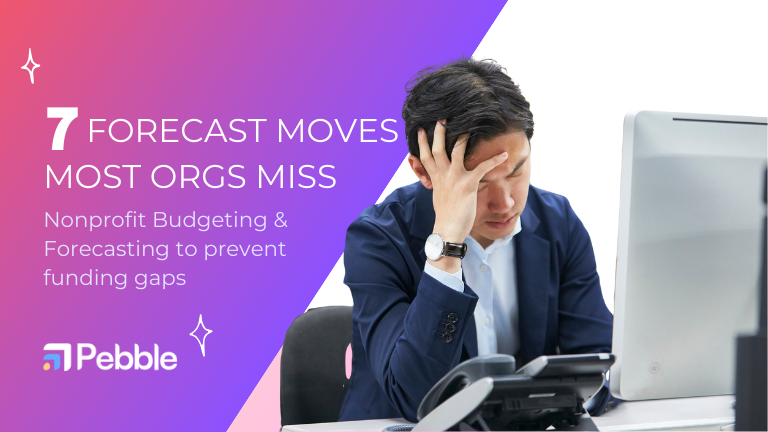For EDs and Program Directors, nonprofit budget planning can’t be a once-a-year spreadsheet exercise. It has to be a living plan tied to programs, grants, and decision-making. When budgets drift, you risk either underspending allowable revenue or over-running categories. Moving beyond static spreadsheets to integrated, insight-driven planning puts you in control. For context on risk-spotting and forward look, see Predictive Analytics for Nonprofits and our Platform Overview.
1) Clarify purpose and align with mission (before you model)
Pain: Budgets built in a finance silo don’t reflect program realities; assumptions aren’t documented; grant terms are overlooked.
What good looks like: Your budget expresses strategy: programs prioritized, reserves protected, grant rules respected.
Actionable (do these first):
- Write a 1-page “budget purpose” memo: growth vs. stabilization, reserves target, near-term risks.
- Map program outcomes → resources (people, OPEX, capital) and tie each to a funding source.
- List each active grant and note constraints (categories, pacing, evidence) using Grant Management Guide and Types of Nonprofit Grants.
- Capture assumptions (new awards, attrition, hiring lags) inline on the budget tab.
Helpful reads: Grant Management Challenges for common pitfalls and fixes.
2) Structure a realistic, flexible model (not a rigid sheet)
Pain: Optimistic revenue; monthly lumping; no runway/contingency; GL categories ≠ contract heads.
What good looks like: Monthly budget with clear fixed vs. variable costs, reserve logic, and scenario toggles.
Actionable:
- Model monthly revenue by stream (individuals, grants, earned, events). Use a conservative base and a stretch case.
- Separate fixed vs. variable expenses; stage hiring and procurement (date-effective lines).
- Track liquidity and breathing room with KPIs like Survival Ratio (Runway) and Liquid Funds Indicator.
- Where grants are involved, think in contract heads—not just GL accounts. See Grant Spend-Down Control for pacing and thresholds.
- If you’re still cross-copying tabs, compare your approach with Grant Software vs. Spreadsheets.
Pebble’s Grant Performance Tracking lets you build budgets by funder terms and still map to your GL automatically.
3) Build a collaborative process (so teams actually own it)
Pain: Finance builds; programs react; the board sees a dense pack but not a story.
What good looks like: Deadlines, drafts, and clear ownership—plus reporting that leaders can act on.
Actionable:
- Publish a budget calendar (drafts, review gates, approvals) and share it cross-functionally.
- Give program leads a light template to request resources and flag risks; bring those into the master model.
- Define the 6–8 board-level KPIs that tell the story—then structure the budget to feed them.
- Plan your narrative early using How to Create a Standout Nonprofit Annual Report so the budget rolls up cleanly into board/funder packets.
- Stabilize earned/repeatable revenue lines by maturing stewardship—see Build a Recurring Donor Base.
Pebble’s Automate Financial Reporting with Reporting Studio turns your budget into board/funder-ready packets—no rebuilds.
4) Monitor budget vs. actual monthly (and course-correct fast)
Pain: “Set and forget” budgets; surprises in Q3; scramble at year-end; missed reimbursements.
What good looks like: Monthly (even weekly for grants) reviews; alerts for hot/cold lines; pre-agreed actions.
Actionable:
- Operate from one source of truth. Track pacing and category utilization with the playbook in Grant Spend-Down Control.
- Use predictive signals to act early (lapse risk, cost drift, demand shifts): Predictive Analytics for Nonprofits.
- Keep a standing “variance actions” list (freeze reclasses, pull-forward allowable activities, re-sequence spend, draft modification).
- Re-check payroll/FTE splits to keep programs correctly costed—see Payroll Program→Program Expense KPI.
Pebble AI flags variances, suggests actions, and helps program/finance teams review the same live view.
5) Tie budgets to grants, programs, and outcomes (close the loop)
Pain: Budgets drafted one way; grants report another; program outcomes live elsewhere.
What good looks like: Budget lines roll up to programs and grants; reporting shows money and outcomes.
Actionable:
- For each material program, link budget lines to grant contracts and outcomes so reporting is plug-and-play. See Grant Management Guide.
- Add a quarterly “portfolio view” to rebalance focus toward ROI/mission return; revisit Maximize Grant Revenue.
- Document how changes hit cash and runway via Survival Ratio.
- Keep context current with a skim of the Nonprofit Blog hub for new playbooks and KPI posts.
Pebble’s Platform Overview shows how budgeting, analytics, and reporting share one spine—so budget updates cascade cleanly into funder/board materials.
6) Quick setup checklist (use for your next cycle)
- Purpose memo finished; assumptions documented.
- Grant inventory completed; constraints mapped (Grant Management Challenges).
- Monthly model with fixed/variable split; contingency & scenarios built.
- Liquidity KPIs wired (Survival Ratio, Liquid Funds Indicator).
- Budget calendar live; owners assigned; board KPIs chosen.
- Variance review cadence and actions defined (Grant Spend-Down Control).
- Reporting flow ready (Automate Financial Reporting).
Conclusion: budgeting that leaders can run on
Nonprofit budget planning should be mission-first, monthly, and measurable. When you align purpose, model realistically, bring teams into the process, monitor often, and connect budgets to outcomes, you reduce risk and unlock capacity. The result: fewer surprises, stronger funder confidence, and more mission per dollar. If you want the infrastructure that makes this easy—budgets, analytics, AI insights, and reporting already connected—see Grant Performance Tracking and the Platform Overview.
- See your budget in action: Reque\st a Demo
- Explore how Pebble connects budgets, analytics & reporting: Platform Overview



.png)
